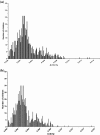The prevalence of glucose-6-phosphate dehydrogenase deficiency in Gambian school children
- PMID: 24742291
- PMCID: PMC3999733
- DOI: 10.1186/1475-2875-13-148
The prevalence of glucose-6-phosphate dehydrogenase deficiency in Gambian school children
Abstract
Background: Primaquine, the only available drug effective against Plasmodium falciparum sexual stages, induces also a dose-dependent haemolysis, especially in glucose-6-phosphate dehydrogenase deficient (G6PDd) individuals. Therefore, it is important to determine the prevalence of this deficiency in areas that would potentially benefit from its use. The prevalence of G6PD deficiency by genotype and enzyme activity was determined in healthy school children in The Gambia.
Methods: Blood samples from primary school children collected during a dry season malaria survey were screened for G6PDd and malaria infection. Genotypes for allele mutations reported in the country; 376, 202A-, 968A- and 542 were analysed while enzyme activity (phenotype) was assayed using a semi-quantitative commercial test kit. Enzyme activity values were fitted in a finite mixture model to determine the distribution and calculate a cut-off for deficiency. The association between genotype and phenotype for boys and girls as well as the association between mutant genotype and deficient phenotype was analysed.
Results: Samples from 1,437 children; 51% boys were analysed. The prevalence of P. falciparum malaria infection was 14%. The prevalence of the 202A-, 968 and 542 mutations was 1.8%, 2.1% and 1.0%, respectively, and higher in boys than in girls. The prevalence of G6PDd phenotype was 6.4% (92/1,437), 7.8% (57/728) in boys and 4.9% (35/709) in girls with significantly higher odds in the former (OR 1.64, 95% CI 1.05, 2.53, p = 0.026). The deficient phenotype was associated with reduced odds of malaria infection (OR 0.77, 95% CI 0.36, 1.62, p = 0.49).
Conclusions: There is a weak association between genotype and phenotype estimates of G6PDd prevalence. The phenotype expression of deficiency represents combinations of mutant alleles rather than specific mutations. Genotype studies in individuals with a deficient phenotype would help identify alleles responsible for haemolysis.
Figures
References
-
- Ceesay SJ, Casals-Pascual C, Nwakanma DC, Walther M, Gomez-Escobar N, Fulford AJ, Takem EN, Nogaro S, Bojang KA, Corrah T, Jaye MC, Taal MA, Sonko AA, Conway DJ. Continued decline of malaria in The Gambia with implications for elimination. PLoS One. 2010;5:e12242. doi: 10.1371/journal.pone.0012242. - DOI - PMC - PubMed
-
- Mtove G, Amos B, Nadjm B, Hendriksen IC, Dondorp AM, Mwambuli A, Kim DR, Ochiai RL, Clemens JD, von Seidlein L, Reyburn H, Deen J. Decreasing incidence of severe malaria and community-acquired bacteraemia among hospitalized children in Muheza, north-eastern Tanzania, 2006–2010. Malar J. 2011;10:320. doi: 10.1186/1475-2875-10-320. - DOI - PMC - PubMed
-
- WHO. Guidelines for the treatment of malaria. Geneva, Switzerland: World Health Organization; 2006.
Publication types
MeSH terms
Substances
Grants and funding
LinkOut - more resources
Full Text Sources
Other Literature Sources
Medical
Miscellaneous


